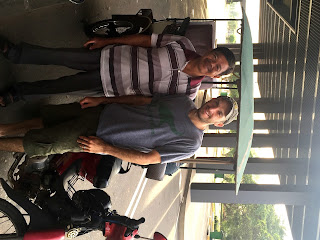After traversing thousands of miles over the course of the prior 6 weeks, we decided to dedicate our final few days in Southeast Asia to enjoying a little R&R, as a lack of overall movement was quite in order. With our destination residing on a small Filipino plot of oceanside paradise, located at the very tip of the island of Palawan, the tiny one-road-in/one-road-out coastal town of El Nido was the perfect destination to say farewell to our time in the Orient. With a pace of life that makes Williamsburg seem chaotic (seriously, what bagel shop doesn't open until 11AM?!), relaxation is not a choice, it is the only option.
With that being said, while the pleasure of watching Julie read crime novels is quite the enjoyable way to pass the hours, a few activity-filled highlights were sorely needed to comprise the remaining 99% of our time:
- Cyclone Avoidance - With July representing one of the "non-preferred" times to visit El Nido due to the nonstop threat of village/vacation-destroying cyclones (at least according to every travel guide/forum/post we came across), we decided to tempt fate, and hope Mother Nature had a more pleasant, tropical-storm-free weather forecast in store for us. Luckily enough (unless you happen to habituate in Taiwan), any potential risk passed by to the North, leaving us with 5 days of perfectly blue skies, clear water, and the occasional, entirely unavoidable, 30-minute afternoon monsoon.
- Accommodation - Having spent upwards of 25 wallet-busting dollars per night for our own small slices of luxury throughout Asia, we made the decision to finally treat ourselves to a "what-any-normal-person-would-spend" form of accommodation, opting for our own cottage overlooking the bay of El Nido. At $85/night, the additional splurge of $60 managed to afford us incredible views, amazing sunsets and a friendly population of food-craving ants that would join us typically 7-8 minutes into our breakfast each and every morning. Oh how i will miss those endless crawling lines, streaming from our balcony directly to the jar of why-did-they-give-us-so-much-sugar.
- Island Hopping Tours - For those unable to spend 5 consecutive days of little to no activity (cough me cough sorry Julie cough cough), the unavoidable go-to option is found in the form of "Island Hopping Tours." With 4 options (appropriately named A, B, C & D), your day is spent aboard an "outrigger," traveling from hidden beaches to secret coves to any other adjective to describe something as "undiscovered, but not really, as there are hundreds of people around you right now." Despite the crowds, which in all reality, were minuscule in comparison to the rest of our trip, our time on tours A & C (obviously the best letters) involved snorkeling, eating delicious freshly-cooked food, and swimming through countless "secret passages" leading to Leonardo Dicaprio-inspired Beaches (capitalized for emphasis).
- Tricycles - As the primary form of transportation around the entire island of Palawan, the hilariously-designed "tricycles" are more of 2001 Space Oddysey-esque time machine, powered by your ever-efficient 110CC motobike. Designed with a bit of "flare" that helps to differentiate one from the other (typically involving the word "Princess" followed by the name of the drivers wife), all of $0.75 is needed to travel to your intended destination (unless of course that destination involves a hill, in which case, your legs are the preferable form of transport).
- Sunsets - It's pretty much like God (or who/whatever you choose to believe has control over sunsets) decided to take a nice LCD trip around 6:30PM each and everyday.
Onto the pics:
Southeast Asia - What the Pho?
For best blog-viewing experience, we recommend utilizing a computer-type device that does not also function as a telephone.
Monday, August 24, 2015
Sunday, August 16, 2015
Angkor Wat: A Quick Layover in the City of Temples
With less than 48 hours in the small city of Siem Reap, Cambodia, home to the world-renowned temples of Angkor Wat, our limited time was reduced even further as whatever stomach bug had previously decimated Julie, slowly caught up to me, having its way in an indescribably-non-fun-at-all manner. After a 24-hour period which I would prefer was erased from my memory banks forever, my futile attempt at "rallying" the following morning for sunrise over Angkor Wat instead involved being carried back in a semi-conscious state to our Tuk Tuk, as my body decided the already-oppressive 5AM heat was just enough to place me in a deep-sweat-near-fainting state.
Nonetheless, 8 bed-ridden hours later, with a nice dose of Cipro working its wonderful magic (once again, hurray for 3rd world pharmaceutical laxness!), I managed to join Julie for round 2 of our 3-hour "sprint" around Angkor Wat, aka the "City of Temples", aka the largest religious monument in the world, aka dammit there are no bathrooms anywhere! And that is all I would like to say about that.
Onto the pics:
Nonetheless, 8 bed-ridden hours later, with a nice dose of Cipro working its wonderful magic (once again, hurray for 3rd world pharmaceutical laxness!), I managed to join Julie for round 2 of our 3-hour "sprint" around Angkor Wat, aka the "City of Temples", aka the largest religious monument in the world, aka dammit there are no bathrooms anywhere! And that is all I would like to say about that.
Onto the pics:
Monday, August 10, 2015
A Slightly-Biased, Somewhat-Stereotypical Overview of Vietnam: Motobikes
Typically know as Vespas or scooters to those of the non-Asian variety, motobikes in Vietnam are more than just a form of transportation, they are an essential part of everyday life. With approximately 35-40 million of these motorized 2-wheelers throughout the nation (if you consider "the internet" a valid source of truth), there is approximately 1 motobike for every person of the "questionably appropriate" age to navigate one. "Sharing" the road with a mere 2 million cars, the whiny, endlessly-honking motobikes are literally the never-ending, pulsing heartbeat of the nation of Vietnam.
With an all-encompassing engine ranging anywhere from 110-125 CC's (for comparison sake, a bottom-of-the-line walk-behind lawnmower has 150 CCs), every single cubic centimeter is put to use by those that rely so heavily upon them. Whether veering around human and/or non-human obstacles, to carrying a load that most F-350 owners would consider too burdensome, there is no doubt these miniature "hogs" are not only vital to life in Vietnam, but also an inevitable presence for years to come.
With that being said, I leave you with a few "tidbits" on motobike-riding in Vietnam:
Rules of the Road - Paying attention to only those bikes in your nearby vicinity will no doubt result in a nice taste of pavement before the day is over. Instead, one must not only pay attention to the bike next to themselves, but also the bike next to that bike, and even the bike next to the bike next to that bike. And so on and so on. If someone 1/2 mile away beings to veer, odds are this is going to impact your location on the road at some point in the near future. Aside from this general "awareness" of one's 1/2 mile radial surroundings, the only other applicable rule is that if a paved area is wide enough for your bike, then ride on through! (this applies to sidewalks, alleyways, crowded markets, and at one point, through the middle of a busy restaurant).
Carrying Capacity - If it can be balanced, it can be carried. From entire extended families (our record witnessed was 6, yes 6) to appliances of any size possible (refrigerators tending to be the most common), all that is needed is a few bungee cords, a friend to help load everything up, and of course an iron will to navigate chaotic traffic with a potential cause-of-death sitting only 6 inches behind you.
Child Placement - While the most common location for those of "pre-driving" age is that of a standing, helmet-less spot at the front of the bike, other acceptable positions include wedged between parents (a "human seatbelt" if you will) or in a resting position on any family members lap (ensuring the head is not placed within range of "oncoming traffic"). Any reduction in traveling speed is deemed unnecessary, as a higher priority to your child's safety is instead the preparation for the inevitable future operation of their own motobike in years to come.
Fuel Efficiency - With a jaw-dropping efficiency rating that puts even-the-smuggest Prius owners to shame, your standard motobike travels approximately 150 miles on a single gallon alone. $3-4 and a full-tank later, and you are pretty much set for the month (and that is only IF you are doing a significant amount of driving).
Crossing The Road - With motobikes competing with humans for any available space possible, the inevitable "encounter" between the two is unavoidable when a street crossing is in order. Although the standard rule of thumb of "walk in a slow steady pace" is accepted by most, putting this guildeline into practice requires a bit of determination, and at least an hour of astonished gawking at others more well-versed then yourself. I leave you with a perfect example from an old (i.e. less bald version of myself) video experienced during my last visit to Vietnam: Crossing the Road in Vietnam
Onto the Best of the Best "Motobike-Stalking" Pics:
With an all-encompassing engine ranging anywhere from 110-125 CC's (for comparison sake, a bottom-of-the-line walk-behind lawnmower has 150 CCs), every single cubic centimeter is put to use by those that rely so heavily upon them. Whether veering around human and/or non-human obstacles, to carrying a load that most F-350 owners would consider too burdensome, there is no doubt these miniature "hogs" are not only vital to life in Vietnam, but also an inevitable presence for years to come.
With that being said, I leave you with a few "tidbits" on motobike-riding in Vietnam:
Rules of the Road - Paying attention to only those bikes in your nearby vicinity will no doubt result in a nice taste of pavement before the day is over. Instead, one must not only pay attention to the bike next to themselves, but also the bike next to that bike, and even the bike next to the bike next to that bike. And so on and so on. If someone 1/2 mile away beings to veer, odds are this is going to impact your location on the road at some point in the near future. Aside from this general "awareness" of one's 1/2 mile radial surroundings, the only other applicable rule is that if a paved area is wide enough for your bike, then ride on through! (this applies to sidewalks, alleyways, crowded markets, and at one point, through the middle of a busy restaurant).
Carrying Capacity - If it can be balanced, it can be carried. From entire extended families (our record witnessed was 6, yes 6) to appliances of any size possible (refrigerators tending to be the most common), all that is needed is a few bungee cords, a friend to help load everything up, and of course an iron will to navigate chaotic traffic with a potential cause-of-death sitting only 6 inches behind you.
Child Placement - While the most common location for those of "pre-driving" age is that of a standing, helmet-less spot at the front of the bike, other acceptable positions include wedged between parents (a "human seatbelt" if you will) or in a resting position on any family members lap (ensuring the head is not placed within range of "oncoming traffic"). Any reduction in traveling speed is deemed unnecessary, as a higher priority to your child's safety is instead the preparation for the inevitable future operation of their own motobike in years to come.
Fuel Efficiency - With a jaw-dropping efficiency rating that puts even-the-smuggest Prius owners to shame, your standard motobike travels approximately 150 miles on a single gallon alone. $3-4 and a full-tank later, and you are pretty much set for the month (and that is only IF you are doing a significant amount of driving).
Crossing The Road - With motobikes competing with humans for any available space possible, the inevitable "encounter" between the two is unavoidable when a street crossing is in order. Although the standard rule of thumb of "walk in a slow steady pace" is accepted by most, putting this guildeline into practice requires a bit of determination, and at least an hour of astonished gawking at others more well-versed then yourself. I leave you with a perfect example from an old (i.e. less bald version of myself) video experienced during my last visit to Vietnam: Crossing the Road in Vietnam
Onto the Best of the Best "Motobike-Stalking" Pics:
Subscribe to:
Comments (Atom)





































































